REMEMBERING CAROL WAYNE / TVparty! (original) (raw)
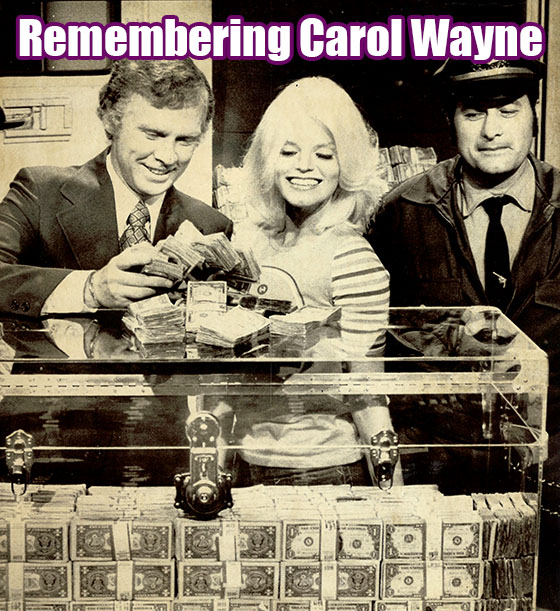
By Cary O'Dell
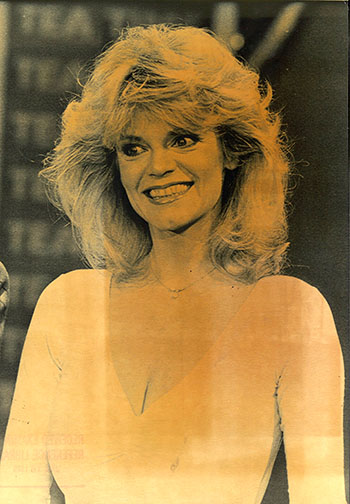 In terms of real life, the “Dumb Blonde” stereotype is unfounded and unfair. But, for many, many years, Hollywood has had fun with the archetype and given many skillful actresses—from Judy Holliday to Jayne Mansfield to Lee Meredith—interesting characters to play.
In terms of real life, the “Dumb Blonde” stereotype is unfounded and unfair. But, for many, many years, Hollywood has had fun with the archetype and given many skillful actresses—from Judy Holliday to Jayne Mansfield to Lee Meredith—interesting characters to play.
And then, of course, we must, include one more performer in this canon: Carol Wayne.
Statuesque and platinum blond, Carol Wayne looked like if Jayne Mansfield and Dick Tracy’s “Moon Maiden” had a baby. She was a fixture on film and, especially, on TV from the late 1960s up through the 1980s.
Wayne was born in 1942 in Lincolnwood, Illinois, a suburb of Chicago. She was born two years before her look-alike sister, Nina. At that time, polio was a dangerous, contagious menace and the Wayne Sisters’ mother believed that the polio virus could not exist at cold temperatures. So, she did what any concerned mother would do--almost as soon as her daughters could walk, she made them take up ice skating.
As faulty as this medical logic might have been, the young Wayne girls nevertheless made good use of their time on the ice. Before long, the sisters were quite adept on blades. But they never went the competitive route; as Carol said later in an interview, “My parents never let us enter figure-skating contests because they did not want us competing against each other.”
Eventually, the Wayne Sisters became so skilled on the ice—and so striking as a duo—they soon attracted the attention of the Ice Capades, who hired them as a sister act.
Wayne said, “We were so young when we started on tour that we had to continue school and some city curfews would not let us play the last evening show.”
Along with those legalities, Carol and Nina had to also observe the sometimes arcane regulations of the Ice Capades organization, including the edict: “There shall be no knitting, tatting, or crocheting in any public lobby, train station or bus depot.”
The Wayne Sisters, who often opened the nightly show with their two-person routine, were a hit with audiences. Wayne would later credit her early skating career with successfully killing of any stage fright she might have had. She said, “I mean, I skated before 40,000 people in Madison Square Garden, and I could have fallen on my rear. Why should I get nervous in front 300 people?”
But, after touring with the show for about two years, Carol injured her knee. Though she got some cartilage removed and ended up with a nearly-invisible scar, her skating days were over.
Carol’s younger sister, Nina, had already moved to Las Vegas to take on her next show biz incarnation. Carol followed soon after, where, and again like Nina, she became a showgirl in one of the city’s then grand showrooms, the Tropicana. Carol said later, “I followed [her]. After all, I couldn’t type or take short-hand.”
Then, not long after that, sister Nina decamped for LA first to try her luck in Hollywood. Nina had gotten off to a solid start, snagging a role on the 1965 TV comedy “Camp Runamuck,” one of the slate of new sitcoms being launched that year by NBC. Though the show only ran for a year, it remains a cult fave. Nina next went to the big screen. She had a role in the tough guy film “Dead Heat on a Merry-Go-Round” in 1966. Her co-stars were James Coburn and, in his film debut, a very young Harrison Ford. The year after, Nina was in “Luv,” a dark comedy that featured Jack Lemmon, Elaine May, Peter Falk and, again in a very small role, Harrison Ford.
Nina would follow those credits up with the film “The Comic” in 1969, the TV movie “The Night Strangler” in 1973 and an amusing role on an installment of “Love, American Style” in 1971. Nina also was, for a time, Drew Barrymore’s stepmom. Nina’s was married to Drew’s dad, John Drew Barrymore, from 1985-1994. Retired from acting now, she resides in California.
As she had when her sister moved to Vegas, Carol would later follow Nina to LA and into the movies and TV industry.
Sometime between the Ice Capades and Hollywood, and perhaps to differentiate herself from her sister, Carol dyed her natural brown locks a platinum blonde. It certainly did make her stand out. Along with her big eyes and voluptuous figure, Wayne opened up her eyes even wider and adopted a soft, breathy voice, one that worked quite well for the flighty, air-headed characters she would soon come to be playing so deftly (and which, unfortunately, largely come to trap her later on).
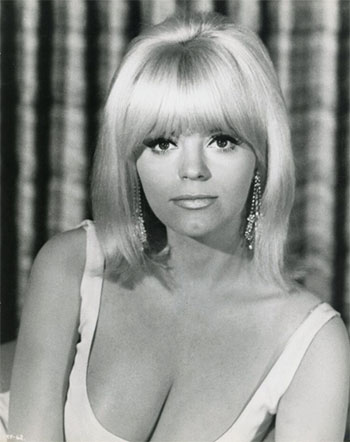 Carol began her acting career deep in the Land of “UNCLE.” In 1966, she guested on “The Man From UNCLE” and, that same year, appeared on its spin-off, “The Girl From UNCLE.” Her “big break” though arrived in 1967 via what seemed to have been a true Hollywood story. Wayne would later recount that she was at a party when “some producer said he was looking for a girl just like me for a show.”
Carol began her acting career deep in the Land of “UNCLE.” In 1966, she guested on “The Man From UNCLE” and, that same year, appeared on its spin-off, “The Girl From UNCLE.” Her “big break” though arrived in 1967 via what seemed to have been a true Hollywood story. Wayne would later recount that she was at a party when “some producer said he was looking for a girl just like me for a show.”
Assumedly, that show was an episode of the 1967 series “I Spy.” It was Wayne’s meatiest role to date and helped place her before the eyes of both the industry (she was Emmy nominated) and the public. Next she was featured in Blake Edwards’s big screen endeavor “Gunn” in 1967 and then in the Peter Sellars comedy “The Party” in 1968. And she did memorable guest spots on “Bewitched” (playing a fluffy bunny who comes to life) and “I Dream of Jeannie” (as a “famous movie star” named Bootsie Nightengale).
Wayne would later boast that she had three generations of fans among those who recognized her in public: kids who knew her from “Bewitched,” young adults who knew for her work on “Love, American Style,” and adults for her reoccurring appearances on Johnny Carson’s “The Tonight Show.”
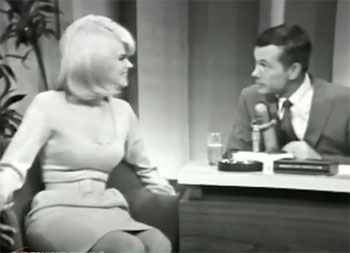 Carol Wayne first came to Johnny Carson and “The Tonight Show” in 1967. It a match made somewhere in comedy heaven. She quickly proved herself the perfect foil for the dry wit and many double (and triple) entendres of show’s legendary host.
Carol Wayne first came to Johnny Carson and “The Tonight Show” in 1967. It a match made somewhere in comedy heaven. She quickly proved herself the perfect foil for the dry wit and many double (and triple) entendres of show’s legendary host.
Though his night-time show was mainly about the art of talk, Carson sometimes filled his evening program with comedy sketches and reoccurring characters. One his most popular characters was playing Art Fern, the rather greasy, fast-talking host/huckster of a local TV afternoon movie show, “The Tea-Time Movie.” For this show-within-a-show, Wayne appeared—blond and very buxom and completely wide-eyed—next to “Fern” and, though her dialogue was minimal, when she had a quip, she made it count.
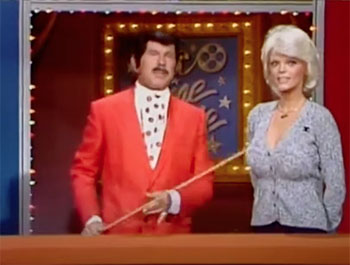 For viewers, the new team of Carson and Wayne were a hit. Wayne would go on to appear on “The Tonight Show” over 100 times. After the skit was performed near the top of the show, she’d also usually be invited back at the end of the program to chat a little bit with Johnny. Interestingly, in her very first appearance on the show, she briefly lamented that casting agents and everyone else in Hollywood only ever saw her as the sex bomb and not as a wife, or mother or anything else.
For viewers, the new team of Carson and Wayne were a hit. Wayne would go on to appear on “The Tonight Show” over 100 times. After the skit was performed near the top of the show, she’d also usually be invited back at the end of the program to chat a little bit with Johnny. Interestingly, in her very first appearance on the show, she briefly lamented that casting agents and everyone else in Hollywood only ever saw her as the sex bomb and not as a wife, or mother or anything else.
Wayne would become such a member of the “Tonight Show” family, she even announced the program a couple of times when Ed McMahon was off. She made her last sketch appearance on the show around 1980 after the Carson show was cut from 90 minutes to one-hour in length and the majority of its non-talk segments were (temporarily) jettisoned.
Along with her frequent late-night appearances, Wayne continued to plug away in series TV (there were six episodes of “Love, American Style,” as well as appearances on “Mannix,” “The Bold Ones,” “The Girl With Something Extra,” and “Emergency!” among other programs).
Additionally, over the years, some of Wayne’s credits were…well, weird. For example, in October of 1975, ABC aired something called “The Second Annual Unofficial Bachelor of the Year Awards.” It was sort of a “Miss America” pageant for the misters and it was hosted by Joan Rivers. The single guys were judged in a dance challenge and in a swimsuit competition and in tests of agility and speed(!). Wayne served on this special’s judging panel alongside Peter Marshall, Abbe Lane and Ellen Corby (yes, “Granda Walton” herself!).
Earlier, in 1972, Wayne was briefly affiliated with a proposed on-air, daily exercise show that was hoping to do for fitness what “The Galloping Gourmet” had done for cooking. The series, to be produced out of Buffalo, NY, and supposedly underwritten by a national chain of fitness “salons,” but it came to an end before it began since Wayne ultimately refused to move to or commute back and forth from Buffalo.
Then, in mid 1975, on NBC’s now iconic “Midnight Special,” Wayne acted as host/interviewer of short, three-minute intra-program segments titled “Rock Rap.” These video inserts featured Wayne chatting with a rock performer or engaging in a little industry gossip—“Will Sonny and Cher get back together?” But these interstitials didn’t really blend with the rest of the “Special” and did not last for long. Wayne was married at the time to “Special’s” producer Burt Sugarman which probably explains how she got this short-lived gig in the first place.
Throughout all this time, Wayne busied herself as a regular on various TV game shows as well, including “Funny You Should Ask,” “Mantrap,” Hollywood Squares” and, most famously, on “Celebrity Sweepstakes.” “Sweepstakes”—yes, produced by Burt Sugarman--ran every day from 1974 to 1976 and featured a panel of six celebrities along with its host Jim McKrell.
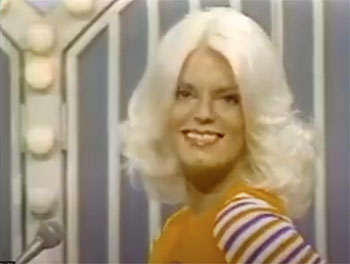 For the game, McKrell posed a trivia question to two contestants and they had to decide which among the six celebs in front of them was most likely to give them the right answer. Much was made around the show’s horse-racing motif from the design of the show’s set to the odds—five to one, nine to one--that contestants were given in terms of the likelihood that the celeb would know what they were talking about.
For the game, McKrell posed a trivia question to two contestants and they had to decide which among the six celebs in front of them was most likely to give them the right answer. Much was made around the show’s horse-racing motif from the design of the show’s set to the odds—five to one, nine to one--that contestants were given in terms of the likelihood that the celeb would know what they were talking about.
Wayne and Joey Bishop were two panelists that appeared the most during the program’s run and they were joined, at various times, by the likes of Buddy Hackett, George Hamilton, Debralee Scott, Bill Bixby, Alan Sues, and numerous others.
It was via this show that Wayne most disproved the stereotypes everyone wanted to have about her. Though her on-air odds were not always in her favor, she regularly showed off her smarts and the contestants that bet on her were often rewarded for it.
Wayne and Sugarman, who had married in 1975, divorced in 1980. He was the last of Wayne’s three husbands. Previously, she’d been married to a Larry Cera from 1965 to 1967 and then to legendary rock photographer Barry Feinstein from 1969 to 1974. She had one child with Feinstein, a son named Alex.
Off screen, Wayne had a number of diverse hobbies. One of them was collecting Native American artifacts, which once included her buying a full trading post from a man in Oklahoma. At one time, her collection was so vast it was utilized for the 1973 feature film “The Man Who Loved Cat Dancing.”
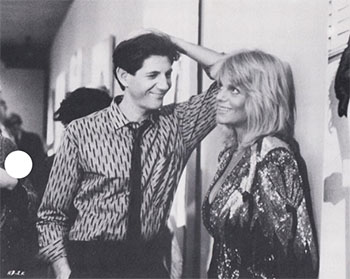 What would turn out to be Wayne’s final film was released in 1984. The film was the drama “Heartbreakers.” It generated for Carol some of the best reviews of her career. Not only did Roger Ebert sing her praises in his review of the film but the “Philadelphia Daily News” called her performance “a tender, thoughtful depiction of a truly objectified woman.”
What would turn out to be Wayne’s final film was released in 1984. The film was the drama “Heartbreakers.” It generated for Carol some of the best reviews of her career. Not only did Roger Ebert sing her praises in his review of the film but the “Philadelphia Daily News” called her performance “a tender, thoughtful depiction of a truly objectified woman.”
Unfortunately, for every triumph that 1984 brought, there were setbacks. That same year, Wayne was forced to file for bankruptcy. Then, on the positive or not, she made many a man’s dream come true when she posed nude for “Playboy’s” in their February 1984 issue. But, as many other actresses have learned, while such exposure might grab some short-lived press attention, it did nothing to really revitalize her career.
Sometime around this time, Wayne, single again, began dating a new man—Edward Durston. Durston was colorful, controversial film director and screenwriter who had been active along the fringes of Hollywood for many years. His film oeuvre included the 1971 grindhouse title “I Drink Your Blood.”
In January of ’85, he and Wayne went on a short getaway to the resort town of Manzanillo, Mexico. The night they were supposed to fly back home—perhaps due to an argument between the couple—Wayne stormed out of the room she was sharing with Durston and went for a walk. She never returned. Several days later, Wayne’s body was found washed up on the shore. Oddly, by the time her body was discovered, Durston had already returned to Los Angeles, leaving Wayne’s luggage behind. Not only that, he never reported her missing. The actress, who, reportedly, could not swim, saw her death officially described as an “accident” but that “official” statement did little to quell questions about the last days, and hours, of Wayne’s life.
After her passing, Wayne’s death was widely reported. Though most articles recounted her various big screen and small screen credits, most centered around her long “Tonight Show” affiliation, making note of her ability to hold her own on TV’s King of Late Night. And there’s nothing “dumb” about that.
Thank you to my friend Mike Heintz for his assistance with this article.
READ ALSO: The Mysterious Death of Carol Wayne!
READ ALSO: The Mysterious Death of Carol Wayne!
